What Is Audience Analysis & Why It Matters for Your Business

What is audience analysis? This methodology serves as the essential framework for all successful marketing initiatives. Whether you're developing a new product, refining your website's UX, or crafting targeted ad campaigns, understanding your target audience enables you to create precisely tailored messaging that drives engagement and conversions.
By analyzing audience demographics, behaviors, and psychographics, businesses gain data-driven insights into customer needs, helping them deliver the right message to the right people at the right time.
What Is Audience Analysis
Audience analysis is the systematic process of evaluating and interpreting key characteristics of a target group, including their interests, behaviors, demographics, preferences, pain points, and purchasing patterns.
In marketing and business strategy, this research methodology enables companies to gain deep consumer insights, helping them better understand both existing customers and potential market segments.
| Get Started Now to Grow Your Online Business with the Best AliExpress Dropshipping Tool - DSers! |
Benefits of Audience Analysis in Marketing
Thorough market understanding establishes the fundamental basis for top-tier promotional campaigns. Audience analysis goes beyond basic demographics—it uncovers behaviors, preferences, and pain points, allowing businesses to craft hyper-targeted strategies. Here’s how leveraging audience analysis can transform your marketing efforts:
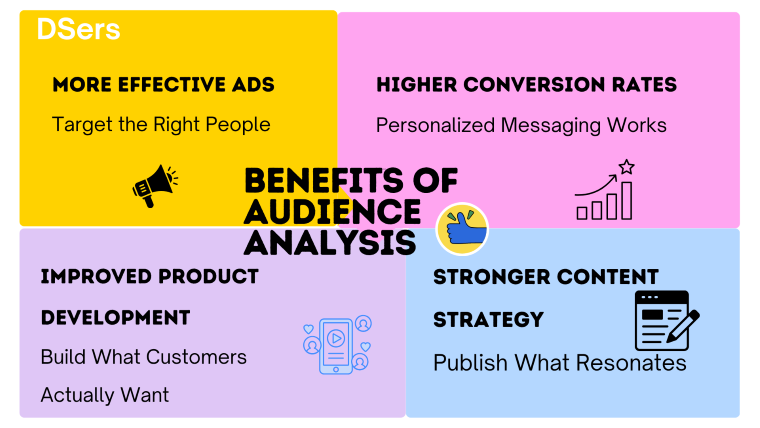
1. More Effective Ads – Target the Right People
Wasted ad spend is a common challenge in digital marketing. Without proper audience analysis, businesses often target broad or irrelevant groups, leading to low engagement and high costs.
By analyzing your audience’s:
- Online behavior (websites they visit, content they engage with)
- Purchase intent (search queries, past buying habits)
- Demographics & psychographics (age, interests, values)
…you can create laser-focused ad campaigns that reach high-intent buyers, reducing wasted budget and boosting ROI.
2. Higher Conversion Rates – Personalized Messaging Works
Customers today expect tailored experiences. A generic "one-size-fits-all" approach no longer works—audience analysis helps you speak directly to different segments.
Key ways personalization improves conversions:
- Dynamic email marketing (segmented lists for higher open rates)
- Custom landing pages (showing relevant offers based on user behavior)
- Retargeting ads (displaying products users previously viewed)
Data shows: Personalized CTAs convert 202% better than generic ones (HubSpot). By using audience analysis, you can craft messages that resonate, leading to more sales.
3. Improved Product Development – Build What Customers Actually Want
Many businesses make the mistake of guessing what their audience wants, leading to failed product launches. Audience analysis removes the guesswork by revealing:
- Unmet needs (through surveys, social listening, and feedback)
- Feature preferences (what customers value most)
- Pain points (frustrations with current solutions)
4. Stronger Content Strategy – Publish What Resonates
Creating content without audience analysis is like shooting in the dark. You might get lucky, but data-driven content performs better.
By analyzing:
- Top-performing topics (using tools like Google Analytics, BuzzSumo)
- Engagement patterns (which formats—videos, blogs, infographics—work best)
- Search intent (what questions your audience is asking)
Leverage these insights to develop targeted content that captures attention, drives interaction, and increases conversions.

|
Adapt Your Product Prices Automatically DSers Automatic Pricing - Pre-set Pricing Rule to mark-up your product price automatically |
Key Components and Types of Audience Analysis
Audience analysis is a multifaceted process that examines critical dimensions to build a complete profile of your target market. By understanding these components and leveraging different analytical approaches, businesses can gain deep insights into who their audience is, what motivates them, and how they interact with their brand.

1. Demographic Analysis
This foundational approach focuses on quantifiable attributes:
- Age & Gender – Reveals generational preferences and gender-specific needs.
- Financial & Educational Background – Impacts buying capacity and decision-making.
- Location – Influences cultural preferences, language, and local market trends.
Application: Essential for segmenting broad audiences and personalizing basic marketing efforts.
2. Psychographic Analysis
Goes beyond demographics to explore psychological drivers:
- Interests & Hobbies – Identifies content and product preferences.
- Values & Beliefs – Shapes brand alignment and messaging resonance.
- Lifestyle & Attitudes – Determines how audiences spend time and money.
Application: Helps craft emotionally resonant messaging and brand positioning.
3. Behavioral Analysis
Examines real-world interactions and habits:
- Consumption Patterns – Reveals repeat purchases, spending thresholds, and brand loyalty.
- Digital Behavior – Tracks website interactions, social media engagement, and content consumption.
- Brand Interactions – Assesses customer service experiences and touchpoint preferences.
Application: Useful for predicting customer decisions and optimizing user journeys.
4. Needs & Pain Points Analysis
Understanding your audience’s needs and challenges is crucial for crafting solutions that drive engagement and conversions. This analysis uncovers:
- Explicit Needs – Directly stated problems or goals, such as a customer searching for "best budget laptops" or "time-saving project management tools." These are clear indicators of what your audience is actively seeking.
- Latent Needs – Unspoken frustrations or desires that customers may not explicitly voice. For example, a user might not say they need "simpler software," but high churn rates could indicate usability issues.
- Barriers to Purchase – Common objections like pricing concerns, lack of trust, or complex buying processes. Identifying these helps refine messaging, pricing strategies, and UX improvements.
Application: Use surveys, customer interviews, and behavioral data to refine product positioning and address friction points in the buyer journey.
5. Contextual Analysis
Audience behavior doesn’t exist in a vacuum—it’s shaped by external factors. This analysis examines:
- Cultural Trends – Shifts in societal values, media trends, or viral topics that influence consumer interests (e.g., sustainability demands or AI adoption).
- Economic Conditions – Recessions, inflation, or employment rates that affect spending habits (e.g., luxury vs. essential purchases).
- Seasonal Factors – Holidays, weather, or industry-specific cycles (e.g., back-to-school sales or winter fitness trends).
Application: Align campaigns with cultural moments, adjust messaging during economic shifts, and leverage seasonal peaks for targeted promotions.
6. Competitive Audience Analysis
Your competitors’ audiences hold untapped insights. This approach helps you:
- Identify Overlaps & Gaps – Discover shared audience segments (for competitive messaging) or underserved niches (for differentiation).
- Discover Underserved Segments – Find customer groups competitors overlook—perhaps a demographic that prefers video tutorials over written guides.
- Uncover Differentiation Opportunities – Analyze competitor reviews to spot recurring complaints (e.g., "poor customer support") and position your brand as the solution.
Application: Use social listening tools, competitor SEO analysis, and customer reviews to refine your unique value proposition (UVP).
7. Technographic Analysis (B2B Focus)
For B2B brands, understanding the tools and tech stacks your audience uses is key. This analysis reveals:
- Product Integrations – If your target businesses rely on Salesforce or Slack, ensure compatibility to reduce adoption barriers.
- Targeted Advertising – Tailor ads to users of specific platforms (e.g., "Seamless Zoom integration for remote teams").
Application: Leverage LinkedIn insights, CRM data, or tools like BuiltWith to align your product with audience workflows.
By integrating these analyses—from psychographics to technographics—businesses move beyond assumptions to data-driven strategies. Whether optimizing ad spend, refining product roadmaps, or outmaneuvering competitors, a 360-degree audience view ensures every decision resonates with real customer needs and market dynamics.
Why Dropshipping Success Starts With Audience Analysis
In today’s data-driven marketplace, audience analysis isn’t just helpful—it’s the difference between brands that thrive and those that fall behind. Moving beyond assumptions to deep, actionable insights transforms guesswork into precision strategy, delivering measurable business impact.
1. Precision Engagement & Personalization
According to Salesforce, 72% of consumers only engage with personalized messaging. By understanding your audience’s pain points and motivations, you create content that:
- Solves real problems (not hypothetical ones)
- Speaks in their voice (tone, style, and preferred channels)
- Reaches them where they are (eliminating wasted visibility)
2. Higher Marketing ROI
Companies that leverage audience analysis often realize 5-8 times greater ROI on campaigns by removing wasteful expenditures through better audience understanding.
- Prioritizing high-value segments
- Cutting underperforming channels
- Optimizing spend based on real behavioral data
3. Stronger Brand Loyalty & Trust
It is said that 86% of buyers pay more for exceptional experiences, based on PwC. Deep audience insights allow you to:
- Anticipate needs before customers voice them
- Build trust through hyper-relevant messaging
- Turn satisfied buyers into vocal brand advocates
4. Future-Proof Strategy
Industry frontrunners predominantly attribute their market dominance to sophisticated consumer profiling techniques. Staying ahead means:
- Spotting emerging trends before competitors
- Adapting quickly to cultural and demographic shifts
- Outmaneuvering brands relying on outdated assumptions
5. Smarter Innovation & Risk Reduction
From product development to CX design, audience analysis:
- Validates ideas with real user needs
- Reduces launch risks by testing with core segments
- Uncovers untapped opportunities competitors miss
Audience analysis serves as the foundation of contemporary marketing, not merely as an initial step but as a perpetual strategy. Forward-thinking brands leverage continuous insights to transform generic messaging into personalized dialogues that fuel long-term business expansion.
How to Conduct an Effective Audience Analysis
Audience analysis is the backbone of successful marketing—it ensures your messaging resonates with the right people at the right time. To execute it effectively, follow this structured approach:
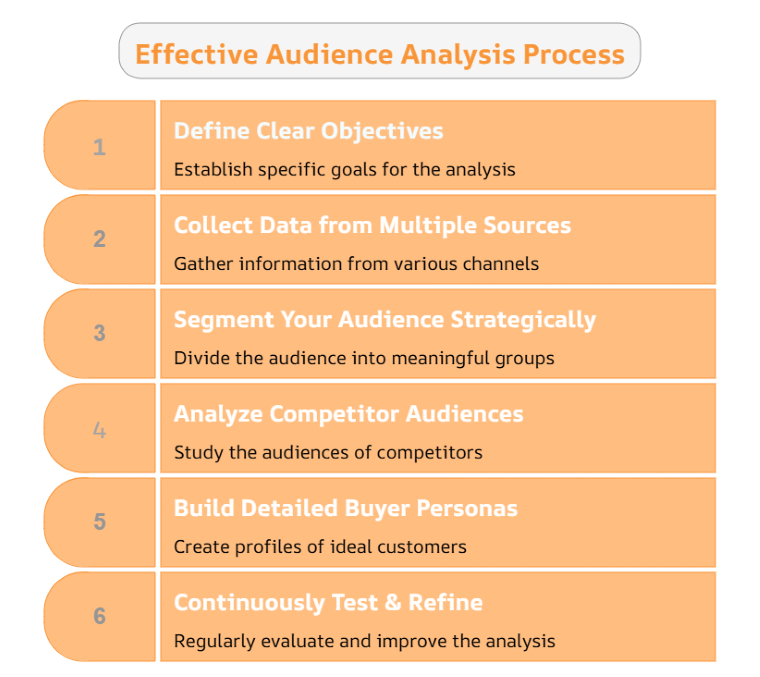
1. Define Clear Objectives
Start by identifying what you need to learn. Are you refining your content strategy, improving ad targeting, or launching a new product? Setting specific goals ensures your analysis stays focused and actionable.
2. Collect Data from Multiple Sources
Integrate statistical data with observational findings to create holistic consumer profiles through:
- Analytics tools (Google Analytics, heatmaps) to track behavior
- Surveys & interviews to gather direct feedback
- Social listening (Brandwatch, Hootsuite) to understand sentiment
- CRM data to analyze past customer interactions
3. Segment Your Audience Strategically
Not all customers are the same. Create strategic audience clusters by grouping based on:
- Demographics (age, location, income)
- Behavior (purchase history, engagement patterns)
- Psychographics (interests, values, pain points)
4. Analyze Competitor Audiences
Study who your competitors are targeting and how. Tools like SEMrush or SparkToro reveal their top-performing content, audience demographics, and engagement strategies—helping you identify gaps or opportunities.
5. Build Detailed Buyer Personas
Turn raw data into relatable profiles. A strong persona includes:
- Background (job, industry, challenges)
- Goals and frustrations
- Preferred content formats and channels
- Objections that might prevent conversion
6. Continuously Test & Refine
Audience preferences evolve, so your analysis should too. Regularly:
- A/B test messaging to see what resonates
- Monitor trends and adjust strategies
- Update personas with fresh insights
Sophisticated audience evaluation operates as a dynamic feedback loop rather than a static checklist. Organizations that excel in this practice develop precisely targeted initiatives, optimize marketing investments, and foster meaningful brand-consumer relationships that withstand market fluctuations.
Hidden Gem Tools for Audience Analysis
Audience analysis helps businesses tailor their messaging, improve engagement, and drive conversions. While popular tools like Google Analytics and Facebook Insights are widely used, there are lesser-known hidden gem tools that can provide deeper insights into your audience’s behavior, preferences, and demographics.
1. SparkToro: Discover Audience Behavior
Most marketers rely on social media analytics, but SparkToro goes deeper by revealing:
- What websites your audience visits
- Which influencers they follow
- What podcasts and newsletters they engage with
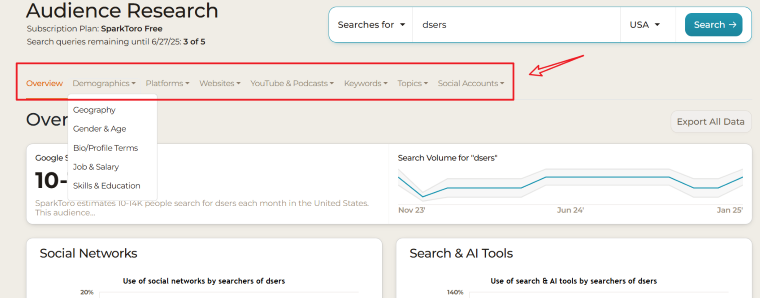
Why it’s a hidden gem: Instead of guessing where your audience spends time, SparkToro provides real data on their online habits.
2. Hotjar: Visualize User Behavior
While Google Analytics shows what users do, Hotjar shows why they do it through:
- Heatmaps (where users click, scroll, and hover)
- Session recordings (real user interactions)
- Feedback polls (direct input from visitors)
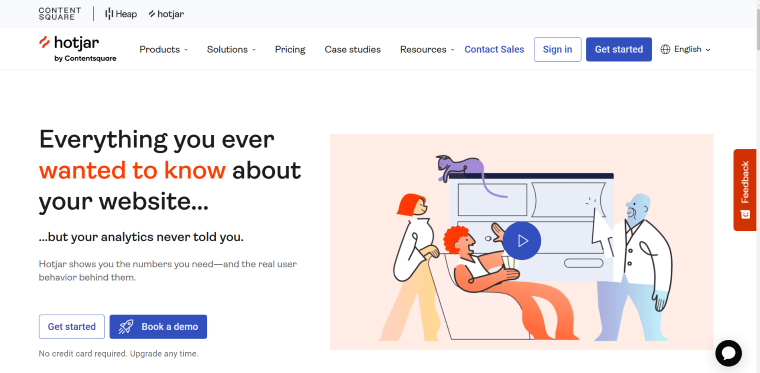
Why it’s a hidden gem: It bridges the gap between quantitative data and qualitative insights.
3. Audiense (Formerly SocialBro): Twitter Audience Intelligence
If Twitter is a key platform for your audience, Audiense helps you:
- Identify key influencers in your niche
- Behavioral patterns and content engagement metrics to identify your most responsive segments.
- Optimize posting times for maximum reach
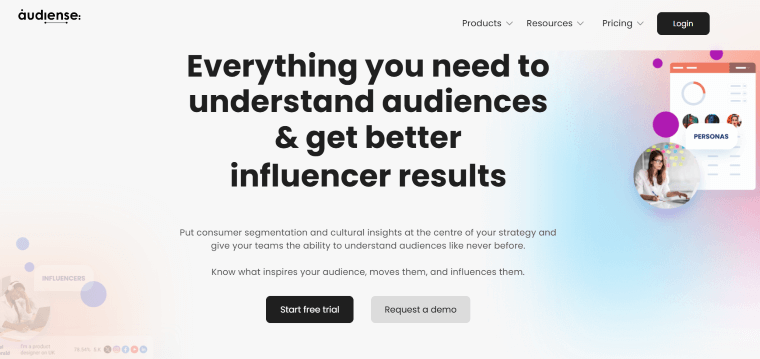
Why it’s a hidden gem: Twitter analytics tools are limited—Audiense provides advanced segmentation.
4. AnswerThePublic: Uncover Audience Questions
Effective audience research goes beyond surface-level statistics it reveals customer challenges and motivations. AnswerThePublic visualizes:
- Common questions people ask about your industry
- Related search queries
- Emerging trends in your niche
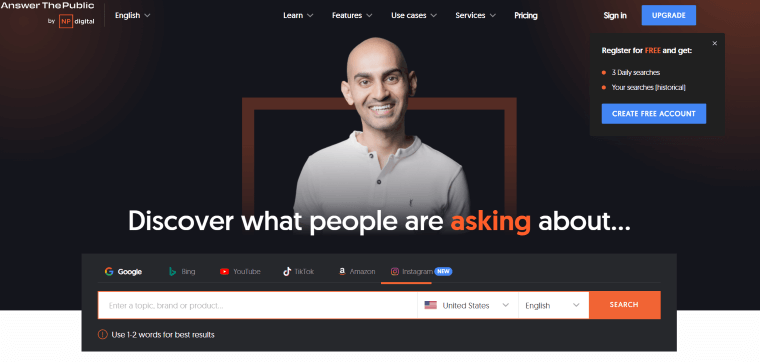
Why it’s a hidden gem: It turns search data into actionable content ideas.
5. CrystalKnows: Personality-Based Audience Insights
Ever wished you could predict how your audience will respond to your messaging? CrystalKnows uses AI to analyze:
- Personality traits of your leads and customers
- Best communication styles for different audience segments
- How to tailor pitches for higher conversions
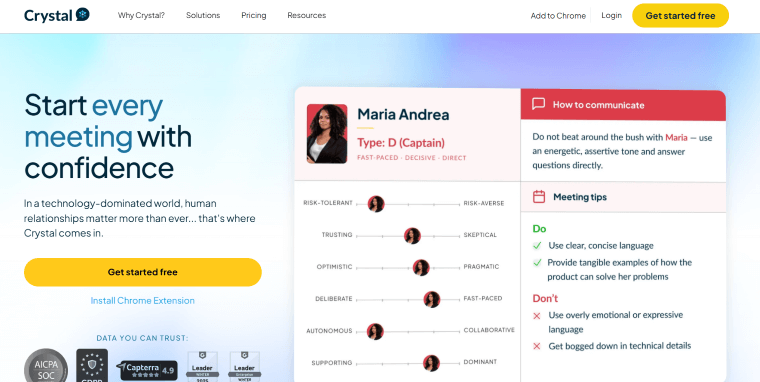
Why it’s a hidden gem: It adds a psychological layer to audience analysis.
6. BrandMentions: Beyond Social Listening
Most social listening tools track brand mentions, but BrandMentions also:
- Monitors untagged mentions (missed by traditional tools)
- Tracks sentiment trends over time
- Identifies emerging audience concerns
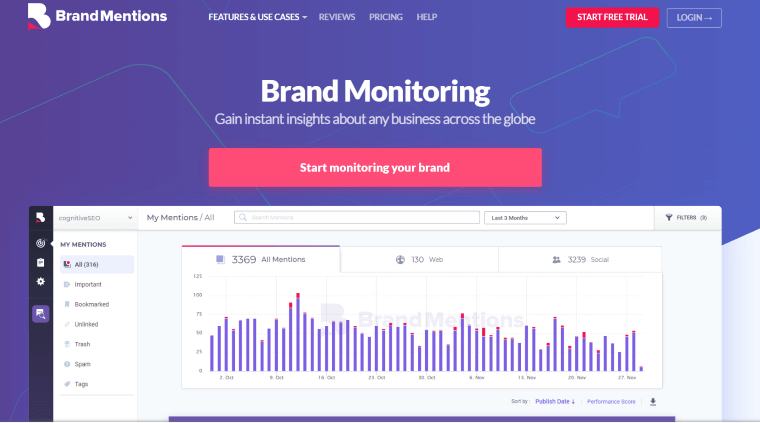
Why it’s a hidden gem: It captures conversations happening outside tagged posts.
How to Choose the Right Audience Analysis Tool
Not every tool will fit your needs. Ask yourself:
- Do I need demographic or behavioral data? (SparkToro vs. Hotjar)
- Is my audience active on social media? (Audiense vs. BrandMentions)
- Do I want psychographic insights? (CrystalKnows)
While mainstream tools provide a good starting point, these hidden gem tools for audience analysis can uncover deeper, actionable insights. Whether you’re refining your content strategy, optimizing ad targeting, or improving user experience, leveraging these tools will help you understand—and engage—your audience better.
Final Thoughts
Audience analysis isn’t a one-time task—it’s an ongoing process. Ongoing audience research ensures you maintain a competitive advantage while cultivating valuable, long-term customer connections.
Ready to analyze your audience? Start with the tools and strategies above to unlock data-driven growth!





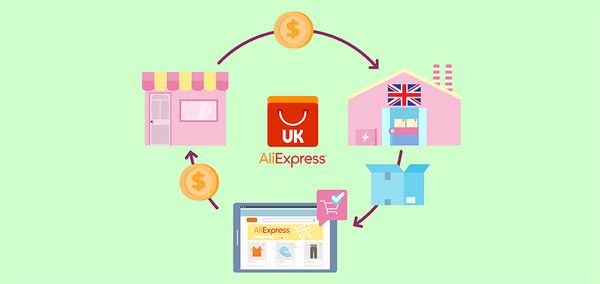






 Company
Company
 Why Choose DSers
Why Choose DSers
 Blog
Blog
 Help Center
Help Center




 Live Chat
Live Chat